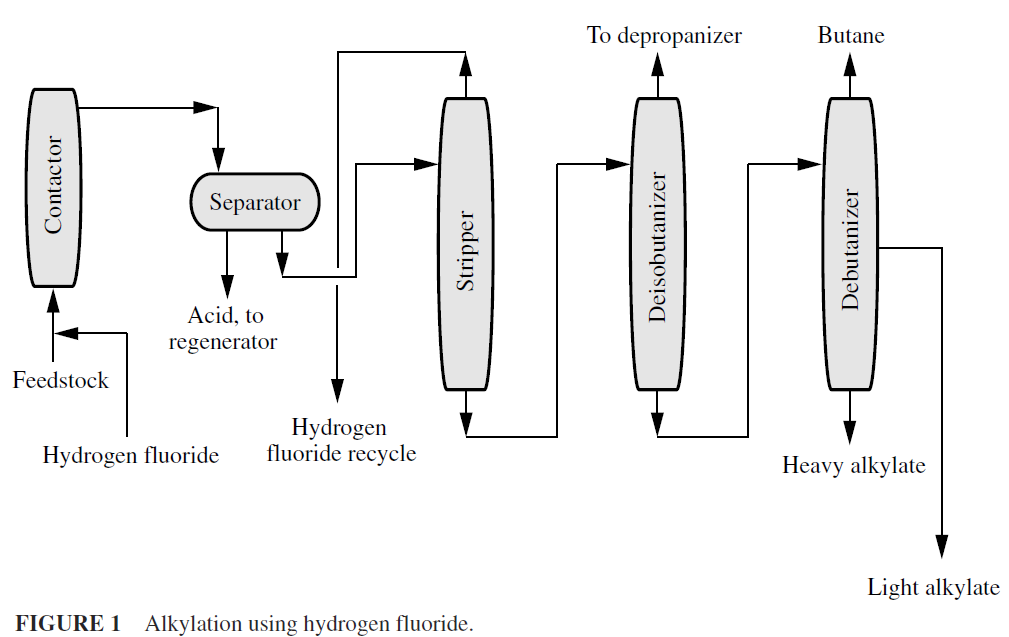


 علم الكيمياء
علم الكيمياء 
 الكيمياء التحليلية
الكيمياء التحليلية 
 الكيمياء الحياتية
الكيمياء الحياتية 
 الكيمياء العضوية
الكيمياء العضوية 
 الكيمياء الفيزيائية
الكيمياء الفيزيائية
 الكيمياء اللاعضوية
الكيمياء اللاعضوية 
 مواضيع اخرى في الكيمياء
مواضيع اخرى في الكيمياء
 الكيمياء الصناعية
الكيمياء الصناعية |
Read More
Date: 12-2-2016
Date: 22-2-2016
Date: 12-2-2016
|
ALKYLATION
Alkylation is usually used to increase performance of a product and involves the conversion of, for example, an amine to its alkylated homologs as in the reaction of aniline with methyl alcohol in the presence of sulfuric acid catalyst:

Thus, aniline, with a considerable excess of methyl alcohol and a catalytic amount of sulfuric acid, is heated in an autoclave at about 200oC for 5 or 6 hours at a high reaction pressure of 540 psi (3.7 MPa). Vacuum distillation is used for purification.
In the alkylation of aniline to diethylaniline by heating aniline and ethyl alcohol, sulfuric acid cannot be used because it will form ether; consequently, hydrochloric acid is employed, but these conditions are so corrosive that the steel used to resist the pressure must be fitted with replaceable enameled liners. Alkylation reactions employing alkyl halides are carried out in an acidic medium. For example, hydrobromic acid is formed when methyl bromide is used in the alkylation leading, and for such reactions an autoclave with a replaceable enameled liner and a lead-coated cover is suitable.
In the petroleum refining industry, alkylation is the union of an olefin with an aromatic or paraffinic hydrocarbon:

Alkylation processes are exothermic and are fundamentally similar to refining industry polymerization processes but they differ in that only part of the charging stock need be unsaturated. As a result, the alkylate product contains no olefins and has a higher octane rating. These methods are based on the reactivity of the tertiary carbon of the iso-butane with olefins, such as propylene, butylenes, and amylenes. The product alkylate is a mixture of saturated, stable isoparaffins distilling in the gasoline range, which becomes a most desirable component of many high-octane gasolines.

Alkylation is accomplished by using either of two catalysts: (1) hydrogen fluoride and (2) sulfuric acid. In the alkylation process using liquid hydrogen fluoride (Fig. 1), the acid can be used repeatedly, and there is virtually no acid-disposal problem. The acid/hydrocarbon ratio in the contactor is 2:1 and temperature ranges from 15 to 35oC can be maintained since no refrigeration is necessary. The anhydrous hydrofluoric acid is regenerated by distillation with sufficient pressure to maintain the reactants in the liquid phase. In many cases, steel is suitable for the construction of alkylating equipment, even in the presence of the strong acid catalysts, as their corrosive effect is greatly lessened by the formation of esters as catalytic intermediate products.
In the petroleum industry, the sulfuric acid and hydrogen fluoride employed as alkylation catalysts must be substantially anhydrous to be effective, and steel equipment is satisfactory. Where conditions are not anhydrous, lead-lined, monel-lined, or enamel-lined equipment is satisfactory.
In a few cases, copper or tinned copper is still used, for example, in the manufacture of pharmaceutical and photographic products to lessen contamination with metals. Distillation is usually the most convenient procedure for product recovery, even in those instances in which the boiling points are rather close together. Frequently such a distillation will furnish a finished material of quality sufficient to meet the demands of the market. If not, other means of purification may be necessary, such as crystallization or separation by means of solvents. The choice of a proper solvent will, in many instances, lead to the crystallization of the alkylated product and to its convenient recovery.
The converse reactions dealkylation and hydrodealkylation are practiced extensively to convert available feedstocks into other more desirable (marketable), products. Two such processes are: (1) the conversion of toluene or xylene, or the higher-molecular-weight alkyl aromatic compounds, to benzene in the presence of hydrogen and a suitable presence of a dealkylation catalyst and (2) the conversion of toluene in the presence of hydrogen and a fixed bed catalyst to benzene plus mixed xylenes.



|
|
|
|
دخلت غرفة فنسيت ماذا تريد من داخلها.. خبير يفسر الحالة
|
|
|
|
|
|
|
ثورة طبية.. ابتكار أصغر جهاز لتنظيم ضربات القلب في العالم
|
|
|
|
|
|
|
العتبة العباسية المقدسة تستعد لإطلاق الحفل المركزي لتخرج طلبة الجامعات العراقية
|
|
|